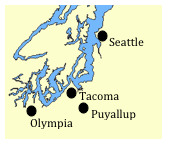Learning Outcomes
- Determine the winner of an election using the Instant Runoff Voting method
- Determine the winner of an election using the Borda Count method
- Determine the winner of an election using the Pairwise Comparisons method.
Instant Runoff Voting
Instant Runoff Voting (IRV), also called Plurality with Elimination, is a modification of the plurality method that attempts to address the issue of insincere voting. In IRV, voting is done with preference ballots, and a preference schedule is generated. The choice with the least first-place votes is then eliminated from the election, and any votes for that candidate are redistributed to the voters’ next choice. This continues until a choice has a majority (over 50%). Note that in the case of exactly three choices, IRV is the same as the single run-off method.
This voting method is used in several political elections around the world, including election of members of the Australian House of Representatives, and was used for county positions in Pierce County, Washington until it was eliminated by voters in 2009. A version of IRV is also used by the International Olympic Committee to select host nations.
Instant Run-off Voting Method
Instant Runoff Voting (IRV) is completed with preference ballots, and a preference schedule is generated. The choice with the least first-place votes is then eliminated from the election, and any votes for that candidate are redistributed to the voters’ next choice. Run-offs continue in this manner until a choice has a majority (over 50%).
Here is a video that includes the definition of IRV, as well as two examples of how to determine the winner of an election using IRV.
Example
Let’s work through one more example using the IRV method. Consider the preference schedule below, in which a company’s advertising team is voting on five different advertising slogans, called A, B, C, D, and E here for simplicity. Use the IRV method to determine the winning slogan.
Another important voting method, Borda Count, assigns points based on their ranking. This method is named for Jean-Charles de Borda, a French mathematician and physicist, who developed the system in 1770.
Borda Count
In the Borda Count method, points are assigned to candidates based on their ranking; 1 point for last choice, 2 points for second-to-last choice, and so on. The point values for all ballots are totaled and the candidate with the largest point total is the winner.
Example
A group of mathematicians are getting together for a conference. The members are coming from four cities: Seattle, Tacoma, Puyallup, and Olympia. Their approximate locations on a map are shown below.

The votes for where to hold the conference were:
| 51 | 25 | 10 | 14 | |
| 1st choice | Seattle | Tacoma | Puyallup | Olympia |
| 2nd choice | Tacoma | Puyallup | Tacoma | Tacoma |
| 3rd choice | Olympia | Olympia | Olympia | Puyallup |
| 4th choice | Puyallup | Seattle | Seattle | Seattle |
Use the Borda count method to determine the winning town for the conference.
This problem is also worked out in the following video.
The final voting method that we will consider was devised by Nicolas de Condorcet, a French philosopher, mathematician, and political scientist. This method is based on pairwise (head-to-head) comparisons between choices.
Pairwise Comparisons (or Condorcet) Method
The pairwise comparisons method considers head-to-head comparisons between all pairs of choices. The choice with the most head-to-head wins is declared the winner with this method. If there is a choice that is preferred in every such pairwise comparison, that choice is called the Condorcet Winner (or Condorcet Candidate).
Example
Consider our vacation club one last time. The members of the club were deciding between Anaheim, Hawaii, and Orlando. Here is the preference schedule we created in the last section. Use the pairwise comparisons method and find the Condorcet Winner if there is one.
| 2 | 3 | 2 | 4 | |
| 1st choice | A | A | O | H |
| 2nd choice | O | H | H | A |
| 3rd choice | H | O | A | O |
Summary of Voting Methods with Three or More Choices
Plurality method: The choice with the most votes wins.
Single run-off method: In a race with three or more choices in which no choice receives a majority, there is a run-off between the two choices with the most first-place votes. The run-off is decided by majority rule.
Instant run-off voting method: Voting is done with preference ballots and the choice with the least first-place votes is eliminated from the election. Then, any votes for that candidate are redistributed to the voters’ next choices. Run-offs continue in this manner until a choice has a majority (over 50%).
Borda count method: Points are assigned to choices based on their ranking. The choice with the largest point total is the winner.
Pairwise comparisons (or Condorcet) method: The choice with the most head-to-head comparisons is the winner. If there is a choice that is preferred in every one-to-one comparison with the other choices, that choice is called the Condorcet Winner.
Candela Citations
- Revision and Adaptaiton. Provided by: Lumen Learning. License: CC BY: Attribution
- Voting Theory: Instant Runoff Voting. Authored by: Sousa, James (Mathispower4u.com). Located at: https://youtu.be/6axH6pcuyhQ. License: CC BY: Attribution
- Instant Runoff Voting . Authored by: Lippman, David. Located at: https://youtu.be/C-X-6Lo_xUQ?list=PL1F887D3B8BF7C297. Project: Open Course Library. License: CC BY: Attribution
- Instant Runoff Voting 2 . Authored by: Lippman, David. Located at: https://youtu.be/BCRaYCU28Ro?list=PL1F887D3B8BF7C297. Project: Open Course Library. License: CC BY: Attribution
- IRV and Monotonicity . Authored by: Lippman, David. Located at: https://youtu.be/NH78zNXHKUs?list=PL1F887D3B8BF7C297. Project: Open Course Library. License: CC BY: Attribution
